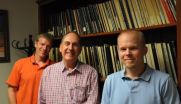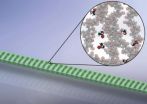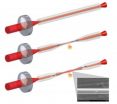(Press-News.org) RIVERSIDE, Calif. — Where sustainability of water management is concerned, we must pay more attention to long-term solutions. Efficient water management and policy ought to be promoted at the local level. And a "portfolio approach" to water management is encouraged, one that includes information campaigns, different types of pricing, supply and reuse options, and technology-based rebate programs.
These are some of the key messages that emerged from the first Urban Water Management Workshop that took place earlier this month at the University of California, Riverside.
Sponsored by the university's Water Science and Policy Center (WSPC) and the School of Public Policy, the workshop brought together academics from a number of research institutions and water agency officials. Nearly 60 people participated in the workshop.
Presentations by the speakers at the workshop can be accessed here.
"This workshop exemplifies our mission at the School of Public Policy of working with the community, policy makers, and public agencies to come up with innovative, evidence-based solutions to the big policy challenges facing our region," said Anil Deolalikar, the dean of the School of Public Policy and a professor of economics. "We at the School of Public Policy and the Water Science Policy Center trust that this workshop has increased our understanding of how to better manage and conserve our scarce water resources in the face of a looming drought."
Riverside is the hub of the Southern California metropolitan water district system, several participants noted at the workshop. The WSPC at UC Riverside is therefore strategically located to help inform local, regional and state policy makers of the efficient ways to manage water and the potential consequences of actions the agencies take.
"What this workshop demonstrated is that there is a need for such workshops to facilitate communication and exchange of ideas," said Ariel Dinar, the director of the WSPC and a professor of environmental economics and policy. "This is a very interesting time to do research on water problems—especially for anyone in California. The agenda is huge and exciting, so much so that I wish I were 20 years younger!"
The one-day workshop stressed the need for data collection for good policy analysis. The WSPC aims to be the hub of data collection for pricing and other policy interventions for water conservation in Southern California.
"We are fortunate to have a lot of local interactions with some wonderful and forward-thinking general managers and efficiency managers in the region, and with their help we can provide valuable service," said Kurt Schwabe, an associate professor of environmental economics and policy. "We certainly want a better understanding of the real-world issues with which the agencies are confronted. There is a disconnect sometimes between what the agencies want and the types of research that academics typically do. To help the agencies, through workshops like the one we just had, we have to reach out and talk to them, figure out what constraints and issues they are confronting."
The workshop underscored the message that most of the effort to balance water supply and demand has to be at the local level, and will involve both additional water conservation as well as greater use of local ground water supplies and recycled water. Also stressed was the need to treat water storage as surface plus ground water supplies, not just surface supplies.
"Our research shows that tiered-pricing works very well to help conserve water," said Ken Baerenklau, an associate professor of environmental economics and policy. "We hope that water agencies will continue to pursue innovative conservation policies as well as efforts to better understand their effects. And we hope customers will keep in mind that people before us made sound investments that today help provide us with safe and reliable water. We need to do our part and continue this practice."
According to Dinar, education is fundamental to water conservation.
"Education and training should begin at the kindergarten level," he said. "Such an investment can reap huge rewards for society later."
One of the goals of the workshop was to strengthen relationships between the WSPC and Southern California water districts.
"We want to provide district managers with information that we think is relevant to them," Baerenklau said. "But we also want to hear what they have to say. The workshop helped us better understand what they are looking out for in the future, what challenges they overcame recently, and what problems keep them up at night. Workshops like this serve to improve communication and foster more collaborative work, benefiting everyone."
INFORMATION:
Dinar, Schwabe and Baerenklau are available for media interviews on urban water management. They can expand on what the workshop delivered and discuss plans at the WSPC aimed at addressing California's drought and water crisis:
Ariel Dinar specializes in water and environmental economics, water policy, climate change, and regional cooperation. He can be reached at (951) 827-4526 and ariel.dinar@ucr.edu.
Kurt Schwabe specializes in water economics, salinity and drainage management and policy, and alternative policy instruments. He can be reached at (951) 827-2361 and kurt.schwabe@ucr.edu.
Ken Baerenklau specializes in conservation technology adoption, water resource economics, and land use and habitat conservation. He can be reached at (951) 827-2628 and ken.baerenklau@ucr.edu.
The University of California, Riverside (http://www.ucr.edu) is a doctoral research university, a living laboratory for groundbreaking exploration of issues critical to Inland Southern California, the state and communities around the world. Reflecting California's diverse culture, UCR's enrollment has exceeded 21,000 students. The campus opened a medical school in 2013 and has reached the heart of the Coachella Valley by way of the UCR Palm Desert Center. The campus has an annual statewide economic impact of more than $1 billion. A broadcast studio with fiber cable to the AT&T Hollywood hub is available for live or taped interviews. UCR also has ISDN for radio interviews. To learn more, call (951) UCR-NEWS.
Urban Water Management Workshop stresses more collaboration and innovation
Academics and water agency officials gathered at UC Riverside on June 4 to discuss California's water crisis
2014-06-17
ELSE PRESS RELEASES FROM THIS DATE:
Swell new sensors
2014-06-17
WASHINGTON D.C., June 17, 2014 – Using microscopic polymer light resonators that expand in the presence of specific gases, researchers at MIT's Quantum Photonics Laboratory have developed new optical sensors with predicted detection levels in the parts-per-billion range. Optical sensors are ideal for detecting trace gas concentrations due to their high signal-to-noise ratio, compact, lightweight nature, and immunity to electromagnetic interference.
Although other optical gas sensors had been developed before, the MIT team conceived an extremely sensitive, compact way ...
Ultra-thin wires for quantum computing
2014-06-17
WASHINGTON D.C., June 17, 2014 - Take a fine strand of silica fiber, attach it at each end to a slow-turning motor, gently torture it over an unflickering flame until it just about reaches its melting point and then pull it apart. The middle will thin out like a piece of taffy until it is less than half a micron across -- about 200 times thinner than a human hair.
That, according to researchers at the Joint Quantum Institute at the University of Maryland, is how you fabricate ultrahigh transmission optical nanofibers, a potential component for future quantum information ...
Study reveals conditions linked to deadly bird flu and maps areas at risks
2014-06-17
BEIJING, CHINA (17 June 2014)—A dangerous strain of avian influenza, H7N9, that's causing severe illness and deaths in China may be inhabiting a small fraction of its potential range and appears at risk of spreading to other suitable areas of India, Bangladesh, Vietnam, Indonesia and the Philippines, according to a new study published today in the journal Nature Communications.
Researchers from the Université Libre de Bruxelles (ULB), the International Livestock Research Institute (ILRI), Oxford University, and the Chinese Center of Disease Control and Prevention analyzed ...
Potential cholesterol lowering drug has breast cancer fighting capabilities
2014-06-17
COLUMBIA, Mo. – Researchers at the University of Missouri have proven that a compound initially developed as a cholesterol-fighting molecule not only halts the progression of breast cancer, but also can kill the cancerous cells.
"Cholesterol is a molecule found in all animal cells and serves as a structural component of cell membranes," said Salman Hyder, the Zalk Endowed Professor in Tumor Angiogenesis and professor of biomedical sciences in the College of Veterinary Medicine and the Dalton Cardiovascular Research Center at MU. "Because tumor cells grow rapidly they ...
Bats make social alliances that affect roosting behavior
2014-06-17
Depending on habitat availability, the endangered Indiana bat may be able to use its social connections to survive a certain amount of roost destruction, according to research by scientists at Virginia Tech and The Ohio State University.
Alexander Silvis of Lynchburg, Ohio, and Andrew Kniowski of Boones Mill, Virginia, both doctoral students in Virginia Tech's College of Natural Resources and Environment, made findings from Ohio State field studies highly visual by applying graphic and spatial approaches to the data.
"Social dynamics are important to bat roosting behavior," ...
Researchers map genomic differences in yellow fever, malaria mosquitoes
2014-06-17
Virginia Tech entomologists have developed a chromosome map for about half of the genome of the mosquito Aedes agypti, the major carrier of dengue fever and yellow fever.
With the map, researchers can compare the chromosome organization and evolution between this mosquito and the major carrier of malaria, the Anopheles gambiae mosquito, to find ways to prevent diseases.
"Despite looking somewhat similar, these mosquitoes diverged from each other about 150 million years ago. So, they are genetically further apart than humans and elephants," said Maria Sharakhova, a ...
Study reveals livestock gut microbes contributing to greenhouse gas emissions
2014-06-17
"Increased to levels unprecedented" is how the Intergovernmental Panel on Climate Change (IPCC) described the rise of carbon dioxide, methane and nitrous oxide emissions in their report on the physical science basis of climate change in 2013. According to the US Environmental Protection Agency (EPA), the atmospheric concentration of methane, a greenhouse gas some 28 times more potent than carbon dioxide has been steadily growing since the 18th century and has now increased by 50 percent compared to pre-industrial levels, exceeding 1,800 parts per billion.
The EPA attributes ...
'Vital signs' of teaching captured by quick, reliable in-class evaluation
2014-06-17
A 20-minute classroom assessment that is less subjective than traditional in-class evaluations by principals can reliably measure classroom instruction and predict student standardized test scores, a team of researchers researchers reported.
The assessment also provides immediate and meaningful feedback making it an important new tool for understanding and improving instructional quality, according to psychologists from the University of Rochester and the University of North Carolina at Chapel Hill.
"Education researchers broadly agree that teachers matter," explained ...
EHRA White Book 2014 highlights growing use of complex therapies for heart rhythm abnormalities
2014-06-17
Nice, France, 17 June 2014. The EHRA (European Heart Rhythm Association) White Book 2014 will be officially launched at the CARDIOSTIM EHRA EUROPACE 2014 congress which starts today in Nice, France.
The White Book reports on the current status of arrhythmia treatment in 49 of the 56 European Society of Cardiology (ESC) member countries for the year 2013. The new White Book is published in electronic format only and will be distributed on a USB stick as well as being available on the EHRA website. As a new feature, the USB stick contains complete data also from the six ...
Distracted minds still see blurred lines
2014-06-17
VIDEO:
Participants were asked to look at an image with moving sections blurred, while performing a cognitive 'n-back' task.
Click here for more information.
Montreal, June 17, 2014 — From animated ads on Main Street to downtown intersections packed with pedestrians, the eyes of urban drivers have much to see. But while city streets have become increasingly crowded with distractions, our ability to process visual information has remained unchanged for millions of years. ...
LAST 30 PRESS RELEASES:
Manta rays create mobile ecosystems, study finds
Study: Mixed results in using lipoic acid to treat progressive multiple sclerosis
Norbert Holtkamp appointed director of Fermi National Accelerator Laboratory
New agentic AI platform accelerates advanced optics design
Biologists discover neurons use physical signals — not electricity — to stabilize communication
Researchers discover that a hormone can access the brain by hitchhiking
University of Oklahoma researcher awarded funding to pursue AI-powered material design
Exploring how the visual system recovers following injury
Support for parents with infants at pediatric check-ups leads to better reading and math skills in elementary school
Kids’ behavioral health is a growing share of family health costs
Day & night: Cancer disrupts the brain’s natural rhythm
COVID-19 vaccination significantly reduces risk to pregnant women and baby
The role of vaccination in maternal and perinatal outcomes associated with COVID-19 in pregnancy
Mayo Clinic smartwatch system helps parents shorten and defuse children's severe tantrums early
Behavioral health spending spikes to 40% of all children’s health expenditures, nearly doubling in a decade
Digital cognitive behavioral treatment for generalized anxiety disorder
Expenditures for pediatric behavioral health care over time and estimated family financial burden
Air conditioning in nursing homes and mortality during extreme heat
The Alps to lose a record number of glaciers in the next decade
What makes a good proton conductor?
New science reporting guide published for journalists in Bulgaria
New international study reveals major survival gaps among children with cancer
New science reporting guide published for journalists in Turkey
Scientists develop a smarter mRNA therapy that knows which cells to target
Neuroanatomy-informed brain–machine hybrid intelligence for robust acoustic target detection
Eight SwRI hydrogen projects funded by ENERGYWERX
The Lundquist Institute and its start-up company Vitalex Biosciences Announces Strategic Advancement of Second-Generation fungal Vaccine VXV-01 through Phase 1 Trials under $40 Million Competitive Con
Fine particles in pollution are associated with early signs of autoimmune disease
Review article | Towards a Global Ground-Based Earth Observatory (GGBEO): Leveraging existing systems and networks
Penn and UMich create world’s smallest programmable, autonomous robots
[Press-News.org] Urban Water Management Workshop stresses more collaboration and innovationAcademics and water agency officials gathered at UC Riverside on June 4 to discuss California's water crisis





